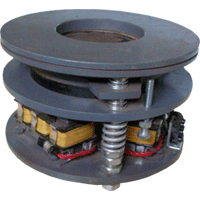info@magcocranes.com
|
|
When magnet is fixed to the frame or any other rigid support and armature assembly is installed on braking shaft, clutch works as a brake. ln this case slip rings are not required. Two types of mountings, internal and external are available. SELECTION OF BRAKE: When braking torque is assumed to be equal to the starting torque, then the brake selected by this assumption will stop the mechanism at least as fast as the time it took for the motor to bring the load up to speed. When instantaneous braking is required, braking torque should be two to three times more than starting torque. START-STOP UNITS (CLUTCH AND BRAKE COMBINATION): A combination of clutch and brake is also available with us. These units are used in winding, wire drawing machines, etc. where starting and stopping of machine is controlled. lnching operations are also possible with the help of this unit. (Separate sheet on start—stop unit will be sent on request). We also manufacture spring loaded Electromagnetic Disc type A.C. & D.C. Brakes. Separate leaflet is available on this, but a brief comparison between these two types of brakes is given below. |
Comparison of D.C. (Normally off) and Spring Loaded A.C. or D.C. (Normally on) Brakes
|
D.C. BRAKES (Normally off) |
A.C. or D.C. BRAKES (Normally on) |
|
Compact and Light in Weight. |
Heavy and Bulky |
|
No Maintenance and Adjustments. |
Requires adjustments & little maintenance. |
|
Consumes negligible power. |
Consumes little more power than equivalent brake. Normally off brake. |
|
Consumes current only when brake is applied. |
Consumes current at all times when machine is running |
|
Shaft can pass through brake body. |
Shaft can go through brake under certain conditions only. |
|
Starter Switch, Relay or some other arrangement is required for actuation of brakes |
Brake is connected in parallel with motor and no special device is required to actuate the brake. |
|
Braking is not positive i.e. current fails, brake will not work. |
Even if current fails, brake will hold the load and rotating mass as it is, hence called Fail-Safe brakes. |
|
Used in machine tools, printing, bottling, wire drawing, textile machinery etc. |
Used for hoist, cranes, winches, lifts etc. (accident prone equipment). |



